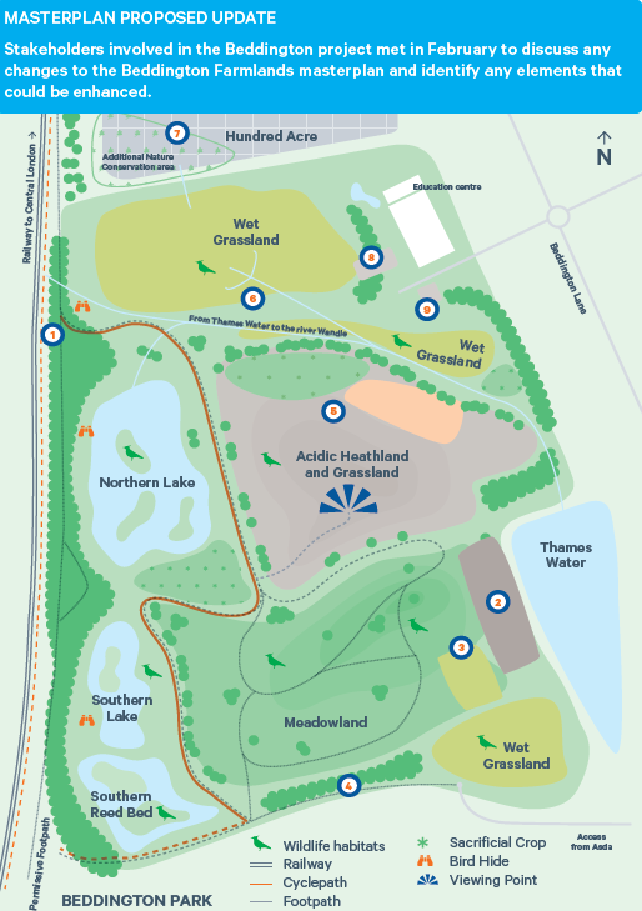Beddington Farmlands habitat creation continues this autumn

Viridor’s restoration of the 120-hectare Beddington Farmlands in South London is continuing with the creation of the first phase of the wet grassland habitat, including the start of a seeding programme that has seen over 150kg of seed spread across this first phase ahead of further habitat management.
In the past decades the Farmlands, located in the London Borough of Sutton, has supported the safe disposal of the non-recyclable waste of one million Londoners. With the increasing preference for landfill diversion and the move towards energy recovery, the landfill site has now closed. Viridor is restoring the Farmlands and creating a network of high-quality wildlife habitats and public access.
One of the key habitats to be created at the Beddington Farmlands is wet grassland, this replicates formerly common habitat found on river floodplains. Across the UK many wet grasslands were drained for agricultural purposes, such that over 90% have been lost. With the first phase of wet grassland now completed, seeded and managed, the site team’s attention will now turn to the second and third phases which may be created by the end of the year.
Marcus Kohler, director of MKA Ecology shared a perspective on the project: “The creation of wet grassland is a key restoration goal at Beddington that will create breeding habitat for target species, notably lapwing, a species on the red list of conservation concern. Lapwing have historically bred at Beddington on the sludge beds, created through the traditional management process of sewage management. Now that this process no longer takes place, the creation of the equivalent of 15 football pitches of wet grassland is fundamental to the sustainability of this unique urban population. With good management, it will also become a significant resource for migrating waders, and other target species such as Little ringed plover.”
Adrian Frost, Head of Project Delivery for Viridor, said: “We are pleased to deliver the first phase of the wet grassland at Beddington, we know that operations across the Beddington Farmlands is changing with the cessation of sewage sludge being spread across the site. To support the lapwing population at Beddington, we are continuing to manage the sludge drying beds to ensure that the lapwing continue to find suitable habitats onsite as the new wet grasslands establish. The community can also follow this journey with our restoration roadmap now updated for 2020 and will be installed in the bird hides accessible from the permissive footpath. Viridor is also working with the newly appointed Farmlands warden and members of the Conservation and Access Management Committee to develop the first in a series of interpretation boards to be installed in the bird hides for members of the community to engage with the establishing wet grasslands.”
Steve Thomas, long-time member of the Beddington Farm Bird Group added: “Wet grassland habitat is one of the most rapidly declining habitats in Britain, so this is an important area of conservation work. At Beddington Farmlands, the newly created habitat may just be mud and water now, but as it develops it will form low vegetation with wet areas and become a very suitable stopover point for migratory wading birds, some of which will be undertaking huge journeys from the very North of Europe to the West of Africa. As a breeding species, lapwing in the UK is of great conservation concern, at the Beddington Farmlands they have previously bred on the north of the site, due to changing industrial uses of the site, historic sludge spreading has now stopped, these beds are now drying out and are unsuitable for breeding lapwing. Hence the importance of the new wet grassland area.”
Cllr Tim Foster, Independent councillor for Beddington North and Chair of the Conservation and Access Management Committee said: “I recently visited the site as the chair of the Conservation and Access Management Committee for the Beddington Farmlands, the site is still a working area but Viridor is turning former waste land into a nature reserve. This summer wet grassland habitat has been created to the north of the site with channels and islands with some of the birds already enjoying it. The Conservation and Access Management Committee is a partnership between Thames Water, Viridor, the London Borough of Sutton and most importantly the community – representatives form Hackbridge and Beddington. That is what this whole project is about, the community and restoring the Farmlands for their use.”

For more information, please visit our website or email us on Beddingtonfarmlands@viridor.co.uk
ENDS
Mark writes: this habitat recreation project, or at least the speed of progress of it, has been a matter of controversy – see Peter Alfrey’s guest blog on the subject here in May 2016. I wonder what Peter and others think of this…?
[registration_form]
On a typo spree? Please re-read “Mark writes” bit again
This is what I make of it : http://peteralfreybirdingnotebook.blogspot.com/2020/10/beddington-farmlands-viridor-press.html